Up Jumped Three: Music With Permanence
by Susan Frances
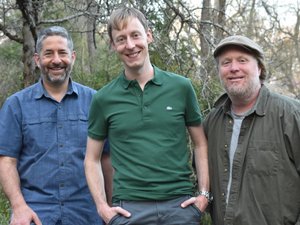 The digital age has proven to have a wide range of benefits and also disadvantages. One benefit allows listeners the opportunity to stream music for free. At the same time, these digital music files are easy to dispose of when interest in them wanes. The members of the jazz trio Up Jumped Three (UJT) would like to see this trend change, driven to compose original music that listeners want to own and keep with them through their lifetime. Oddly, it has been the extensive closing of economies around the world caused by the COVID-19 epidemic that has brought this message front and center for UJT.
The digital age has proven to have a wide range of benefits and also disadvantages. One benefit allows listeners the opportunity to stream music for free. At the same time, these digital music files are easy to dispose of when interest in them wanes. The members of the jazz trio Up Jumped Three (UJT) would like to see this trend change, driven to compose original music that listeners want to own and keep with them through their lifetime. Oddly, it has been the extensive closing of economies around the world caused by the COVID-19 epidemic that has brought this message front and center for UJT.
“In the midst of the COVID-19 crisis,” UJT’s double bassist Bryan White explains, “we had to cancel our CD release show that was scheduled for March 28th. I’ve pondered this a lot since then,” he muses, “in terms of where live music goes from here. I honestly hope that with live performances essentially ‘on hold’ indefinitely, I hope people come back to recorded music and realize what a value it has, and how much artists depend on listeners committing to buying and owning music… and that they learn to cherish and appreciate it again, and the work that goes into it.”
He purports, “The ‘culture of free’ has destroyed the value of recorded music so much, but right now it’s the thing that’s giving people joy in so many ways. Streaming is great exposure, but it doesn’t pay the bills at all.”
Owning music may have gone away with the 20th century but it is a practice that serves the artist. Up Jumped Three, comprised of White on double bass, Frank Southecorvo on saxophone and Tim Winter on guitar, each describe how from the start they were inclined to write their own music, and found gratification in making music that has a permanence for them.
White recalls, “When I joined my first rock band in high school, our mission was to write our own music from day one. I was always interested in doing my/our own thing from the start – before I really knew what I was doing on my instrument. I played along with recordings to learn how to play – not as a way to discover what ‘cover songs’ to play, or what licks to cop. I was always encouraged to explore and find my own voice from day one.
“When I got into jazz,” he proclaims, “I recognized that I would learn the ‘language’ by studying and playing standards, but I feel like I can play more like ‘myself’ when it’s on my/our own original material. As a composer, I feel like I have taken elements from standards and found a way to incorporate them into my own writing in a way that feels natural and authentic.”
Southecorvo remembers about his early musical experiences, “I started writing little songs when I was 14 or 15. We had a piano in our house and I was just curious.”
These stepping stones strongly affected him as he prioritizes, “I believe that telling and listening to stories is a big part of what makes humans human. Stories of old dead guys are important, but we wouldn’t have those stories if, in their time, they didn’t tell their stories.”
Winter recounts, “I was inspired to write music soon after I started taking lessons to play guitar. Can’t really say more than that. I just have had music in my head for a LONG time that has needed to come out. And I wouldn’t say that making my own music is more gratifying than playing standards. It’s more of an honor to play songs that I write along side standards that I love.”
“Really,” Winter encapsulates, “in any moment I am simply trying to express emotion sonically whether the inspiration is from an original or a standard. But there is a unique joy one experiences when someone comes up to you at a performance after an original is played and they express their inspiration, their joy from your creation.”
Finding the right instrument to communicate their voices was a natural choice as White admits, “I’ve always been a bassist since day 1. I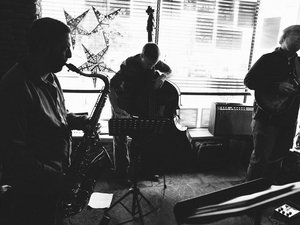 never really wanted to play another instrument… I was always drawn to the bass parts in recordings and obsessed with my sound systems in my house (and later, my car) with having a strong bass presence and punch when listening to music.”
never really wanted to play another instrument… I was always drawn to the bass parts in recordings and obsessed with my sound systems in my house (and later, my car) with having a strong bass presence and punch when listening to music.”
“My biggest influence to start playing bass,” White singles out, “was Jason Scheff, the bassist for the band Chicago. I was fortunate to have a personal connection with him and his family early on and he gave me encouragement and additional direction. His style and ‘active’ approach within a jazz/rock context fueled my love of not only bass itself, but planted the seeds of interest in jazz and jazz fusion styles. Growing up, my best friend’s dad was a bassist and he was my first teacher. Bass was all around me… it just took time for the seed to sprout when I was in my teenage years.”
Southecorvo summarizes about his own formative years, “When I was 8, high school students came to our elementary school and demonstrated lots of instruments and they encouraged us to learn one. I fell in love with the oboe. When I told my mother she said that beginning oboe is really hard to listen to, but she’ll rent me a saxophone.”
Winter responds more playfully, “I saw a picture of a guitar in a catalog when I was 12 and I said to myself that I wanted to play that thing….. No kidding. It looked cool.”
Equally cool and descriptive of the band is the choice for their name, Up Jumped Three. White sets up, “I think we all remember this a little differently. I remember coming up with a list of band names randomly, and we whittled them down from that list. Up Jumped Three was one that didn’t really limit us to one particular ‘style’ designation, and it felt ‘positive’. I was definitely influenced by the name of the standard ‘Up Jumped Spring’ but with a twist.”
Southecorvo supports White’s recollection, “I’m not sure who’s idea it was, but I remember we were getting tunes together for our first gig and we needed a name for the band. We had just played the Freddie Hubbard song, ‘Up Jumped Spring.’ It was a quick fix at the time but I really like the name. It’s open-ended in terms of style. We can play anything and it makes me think of dance.”
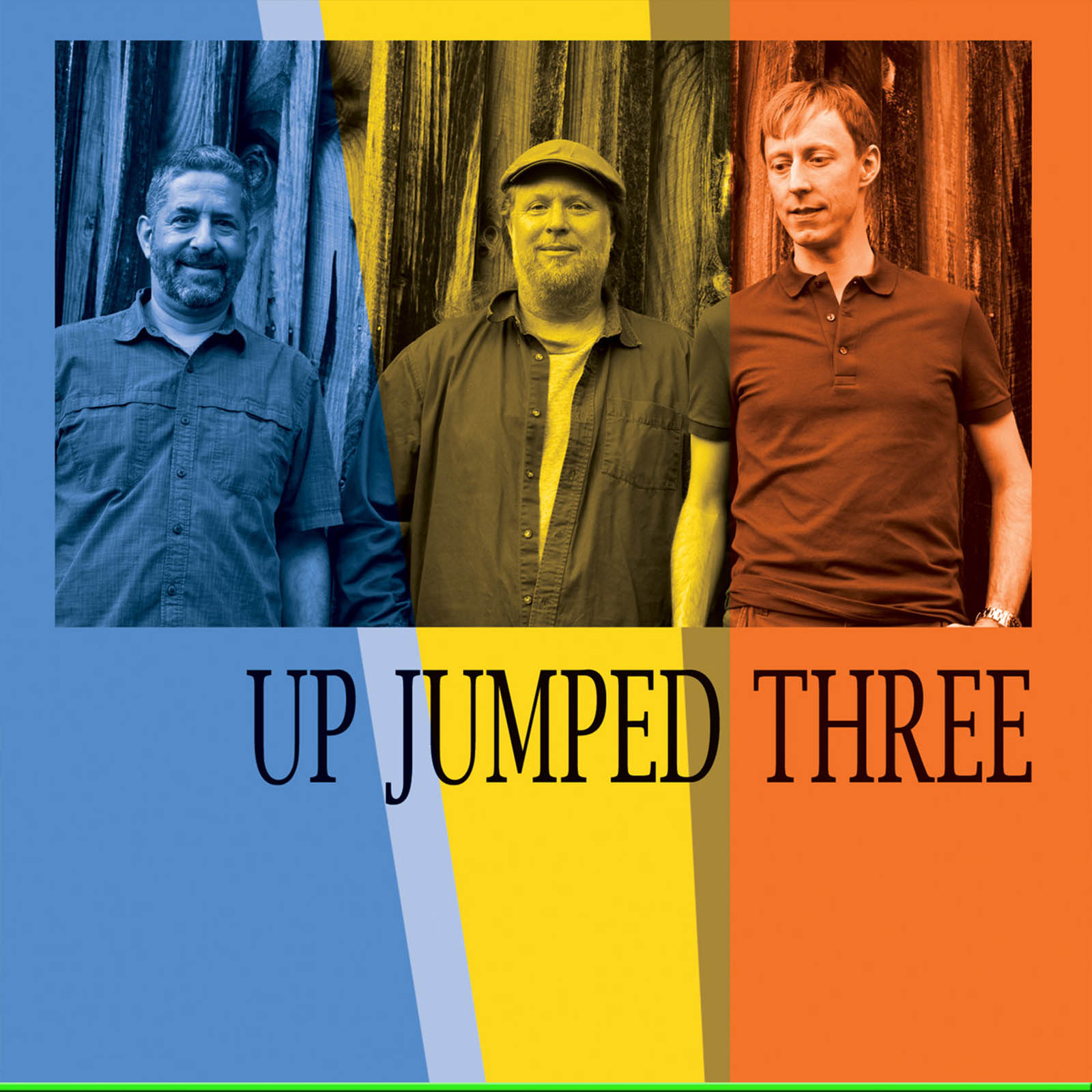 The trio’s latest release is a self-titled recording that came about just as naturally as the band members choice of instrument to play and eagerness to write original compositions. White asserts, “We’re fortunate that we are always writing new music. We typically write, introduce new tunes into our live repertoire, and then record on a ‘rolling’ basis. The best tunes and best recordings get picked, and we whittle down the album from there. We’ve never consciously written a ‘theme’ record per-se, but each record so far has had its own feel. To me, this one feels the most ‘direct’ and cohesive in terms of sound and composition style out of the three we’ve done.”
The trio’s latest release is a self-titled recording that came about just as naturally as the band members choice of instrument to play and eagerness to write original compositions. White asserts, “We’re fortunate that we are always writing new music. We typically write, introduce new tunes into our live repertoire, and then record on a ‘rolling’ basis. The best tunes and best recordings get picked, and we whittle down the album from there. We’ve never consciously written a ‘theme’ record per-se, but each record so far has had its own feel. To me, this one feels the most ‘direct’ and cohesive in terms of sound and composition style out of the three we’ve done.”
Southecorvo adds firmly, “Actually, we never write music for a recording. We record every now and then and every once in a while we say, ‘Hey we’ve got 15 – 20 tunes. Let’s pick the 12/13 best and put out a CD.’ Why now? The process started a while back and why not now.”
Winter extracts about the trio’s composing style, “Nothing really was unique about the motivation for me… we are always writing new material. Is there ever a right or wrong time to release a recording?,” he prompts rhetorically.
The permanence of Up Jumped Three’s compositions is rooted in their inspirations like for “New Beginning” from their self-titled release. Composed by Frank Southecorvo, he opens up about the track, “I wrote this song for my wife Robin who had been an ‘after work artist’ for 30 years and, after retiring, was now going to be able to be in her studio all day. At the time, I was playing more classical music and thinking about how that kind of counterpoint would sound nice with Up Jumped Three because we can each play a separate single note line. In terms of arrangement, some of that happens as a group. I think the section where Tim [Winter] plays big open chords was his idea. We try different things at rehearsal and whatever sounds good sticks.”
The trio’s experimental tendencies while composing is part of their character as White observes, “Unless I have a title in mind that guides the outright mood of the song, or a set of chord changes that I meditate on, I rarely go into a tune or an album with a firm concept of mood or theme. Most of the songs I write start with a tiny melodic seed and I compose via ‘stream of consciousness’ – editing, chopping and slicing and singing ideas until it comes together.”
Elements of smooth West Coast jazz and blues are coalesced with aspects of freestyle phrasing and lyrical exertions, coursing along a stream of consciousness. Each musician tacks on their individual statements, keeping the melodic progressions advancing, producing a give and response bond. No matter which member of the trio may initiate a composition, the others come in with their ideas, building on each other’s riffs and massaging the arrangements until the three members agree with the result.
Southecorvo accesses about the trio’s songwriting method, “One element I think about with this group is having three separate parts that add up to a whole. Not all of our songs feature that but many do. Tim [Winter] often plays single notes rather than chords during our non – improvised sections.”
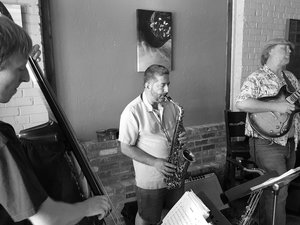 Winter imparts about his part in the trio’s collaborations, “I feel inspired to write something as it comes. I rarely have a theme to start with. I just hear something out of the blue and then try to be creative along with the inspiration. I can say that I am usually melody centric, that is, melody is predominant in what I write and harmony is the support. But whether is’s melody or harmony, the predominant element is emotional stimulation. Is it inspiring? Is it evocative? Is there a story told within the sound?”
Winter imparts about his part in the trio’s collaborations, “I feel inspired to write something as it comes. I rarely have a theme to start with. I just hear something out of the blue and then try to be creative along with the inspiration. I can say that I am usually melody centric, that is, melody is predominant in what I write and harmony is the support. But whether is’s melody or harmony, the predominant element is emotional stimulation. Is it inspiring? Is it evocative? Is there a story told within the sound?”
Considering the question deeper, Winter notes, “I am not sure if I am influenced by my band mates, but many a time I have said about their compositions that, ‘I wished I had written that’.”
The recording process for their self-titled release proved to be just as uniquely executed as the trio’s songwriting process. Due to the lockdown order imposed on families to stop the spread of the coronavirus across the country and around the world, White calculates, “The biggest challenge with recording at home – and recording all at the same time – in a place that’s not a ‘proper’ studio is separation and keeping the tracks as ‘clean’ as possible without sounding sterile.”
He regards, “We also – at some points along the way – had to edit out bird noises, falling branches, and squirrels scampering along the outside deck. We’ve also had to reschedule sessions due to rain – because the mics would have picked up on it too much and ruined the recording. Fortunately, we learned a lot while recording our first two records and have a great setup now that allows us to record easily and relatively consistently, and have learned how to avoid some of those ‘unknowns’ as much as possible. The biggest thing we did along the way was upgrading our microphones. Great mics,” he advises, “just make your recordings sound better, no matter the setting.”
Southecorvo shares about his memories of the recording process, “We don’t piece arrangements together on recordings. We record live playing together. The hardest things in recording for me are 1. not having any audience to play to, and 2. trying to turn off expectations and be willing to try something that might not sound good. At a live gig, I am more likely to try things because if it doesn’t go well, I’m not going to dwell on it but move on to the next thing. A recording is FOREVER.”
“For me,” Winter addresses, “the recording process is a fight between getting the ‘right’ take and just letting something go. I seem to think I can always do a better take. In the end it is a group decision that a take is a keeper or not.”
Comparing the recording process to the live performance experience, each member chimes in with various opinions. White attests, “I love recording, and am an audiophile. In the studio, I take joy in hearing each instrument as it should sound – our individual voices and tones… without fighting the room or a front-of-house engineer who may not understand what an amplified bass (or sax or guitar) needs to sound like. Live, I have to let go of some of my pickiness about tone and I find that I will take more chances in a solo than I might in the studio, because in the studio I am focused on quality of sound, conciseness, and preserving a document of the song that can be listened to multiple times over and over. Live, it’s more about energy and giving something new and unexpected to myself, my bandmates, and the listener.”
“The pros of recording,” Southecorvo deciphers, “are being able to create ideal volume and tonal balance. The other advantage is being able to play the song over if you make mistakes – try it again. The cons are that it’s not real. When playing live you are forced to be in the moment because there is no fixing of mistakes – you play one time only. That coupled with the energy that goes back and forth between audience and performer makes music come alive. When recording, you have to pretend that you are speaking to someone.”
Winter remarks about the comparison between recording and playing live as “Night and day difference! With recording, I tend to play too much in my head trying to “get it right.” Whereas playing live I am just out there playing. There is no chance for a retake and I just let go. I think we are getting better as a band in the studio, but I must say the most sublime stuff we do is live so far. And there is a satisfaction when playing for an attentive audience. There is a communication that just isn’t there in the studio. I guess I just like giving the gift of music when I am playing for someone.”
The trio’s goals for their self-titled release also vary. White proposes, “We simply hope to reach more ears and expose people to the writing and playing that we all love. This is our first release where we went all-in with full digital distribution worldwide, and on all streaming platforms as well.”
Southecorvo’s goal is more sentimental as he submits, “The self-titled release is a document of a time period in the band. We are always moving on to the next songs. It’s nice to have ‘snapshots’ with each CD. The other goal is to make money. We sell CDs live at performances and sell music digitally online.”
In his playful manner, Winter elucidates about his goals for the recording, “Ultimately, to have as many people listen to it as possible and to bring joy to those that hear it.”
The trio’s musical influences may have had a hand in their development as musicians and in making goals for their recording. White reflects about the artists that have impacted him, “Since I didn’t come to double bass from a classical background, my influences have typically always been jazz-leaning when I compose. Growing up in rural western North Carolina, I also find that folk and country influences find their way into my work as well from time to time, which I found were validated when I really discovered Charlie Haden and his work early in my double bass journey. Classical elements sometimes enter as accents, and as I’ve gotten more comfortable as an arco player. Outside of Charlie Haden, I consider Pat Metheny, Scott LaFaro, John Patitucci, and Ornette Coleman as some of my main influences.”
Staying true to his sentimental nature, Southecorvo’s influences have made a permanent effect on him as he cites, “Some musical influences have been with me for a long time. There are many! Here are a few: Abdullah Ibrahim, Charles Mingus, Pharoah Sanders, Wayne Shorter. Most ideas come from the people I’m playing with at the moment. 15 years ago, I was playing pop songs on a commercial gig and the pianist, Bill Gerhardt, played some reharmonizations that changed how I thought about music in a fundamental way. I said ‘What was that?’ The ‘that ended up being 5 – 10 years of study’!”
Winter’s litany of musical influences are wide ranging from jazz to alternate rock and classical music as he lists, “Pat Metheny, Gentle Giant, Radiohead, Jobim, Bela Bartok, Bach, Ralph Towner, John Serry…. so many.”
Like their musical influences, Up Jumped Three want to unequivocally make a lasting impact on their audiences. Their compositions are personal, speaking their thoughts and communicating their bonds in what can be interpreted as being in a family. The permanence they feel about their own music, they hope is shared by their audience.
Like a family, the three members lead their own lives outside the jazz trio. In Southecorvo’s spare time, he reveals, “I have been sketching out arrangements for a saxophone quartet or horn-centric band of some sort. This has been a time to utilize overdubbing to play all parts. I’m posting these on Soundcloud under Frank Southecorvo.”
Additionally, Southecorvo divulges about his private life, “I like to cook. Unfortunately, I also like to eat but I am trying to slow my transition to beach ball by riding my bike which I also like!”
Conversely, White’s spare time is spent in the outdoors. “I am a passionate runner (5k up through half marathon distances), and I spend quite a bit of time training and staying fit for that. I’m also a huge motorsports fan, both IndyCar and Formula 1. As with all things in this time, much of those activities are on hold for now as well, at least in terms of competitive outlets with other people.”
Winter’s response has a more prophetic edge as he professes, “Music as a healing art. Sound healing. Just being in nature whether on my motorcycle or on a trail somewhere.”
Self-motivated musicians like Up Jumped Three are carving out a niche for themselves in the present day digital age. Their utilization of websites that stream and distribute music is making their voices heard. Finding permanence in an age that promotes disposal music is a challenge in itself but that is hardly deterring the jazz trio who believe in the permanence of their music.
About Susan Frances:
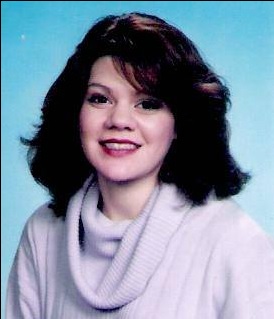 Born in Brooklyn, New York and raised in eastern Long Island, I always enjoyed writing and made several contributions to my high school literary magazine, The Lion’s Pen. Influenced by writers of epic novels including Colleen McCullough and James Clavell, I gravitated to creative writing. After graduating from New York University with a BA in Liberal Arts, I tried my hand at conventional jobs but always returned to creative writing. Since 1998, I have been a freelance writer and have over three thousand articles to various e-zines including: Jazz Times, Blogcritics, Yahoo Voices, Goodreads.com, Authors and Books (books.wiseto.com), TheReadingRoom.com, Amazon.com, Epinions.com, Fictiondb.com, LibraryThing.com, BTS emag, BarnesandNoble.com, RomanticHistoricalReviews.com, AReCafe.com, Hybrid Magazine, and BookDepository.com. In 2013 and 2014, I was a judge in the Orange Rose Writing Competition sponsored by the Orange County chapter of the Romance Writers of America located in Brea, California.
Born in Brooklyn, New York and raised in eastern Long Island, I always enjoyed writing and made several contributions to my high school literary magazine, The Lion’s Pen. Influenced by writers of epic novels including Colleen McCullough and James Clavell, I gravitated to creative writing. After graduating from New York University with a BA in Liberal Arts, I tried my hand at conventional jobs but always returned to creative writing. Since 1998, I have been a freelance writer and have over three thousand articles to various e-zines including: Jazz Times, Blogcritics, Yahoo Voices, Goodreads.com, Authors and Books (books.wiseto.com), TheReadingRoom.com, Amazon.com, Epinions.com, Fictiondb.com, LibraryThing.com, BTS emag, BarnesandNoble.com, RomanticHistoricalReviews.com, AReCafe.com, Hybrid Magazine, and BookDepository.com. In 2013 and 2014, I was a judge in the Orange Rose Writing Competition sponsored by the Orange County chapter of the Romance Writers of America located in Brea, California.





No Comments